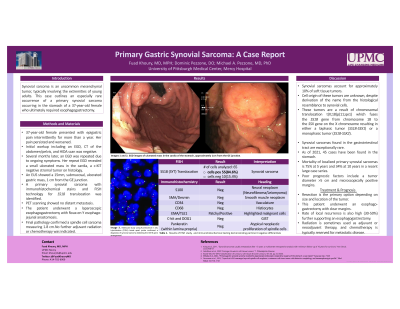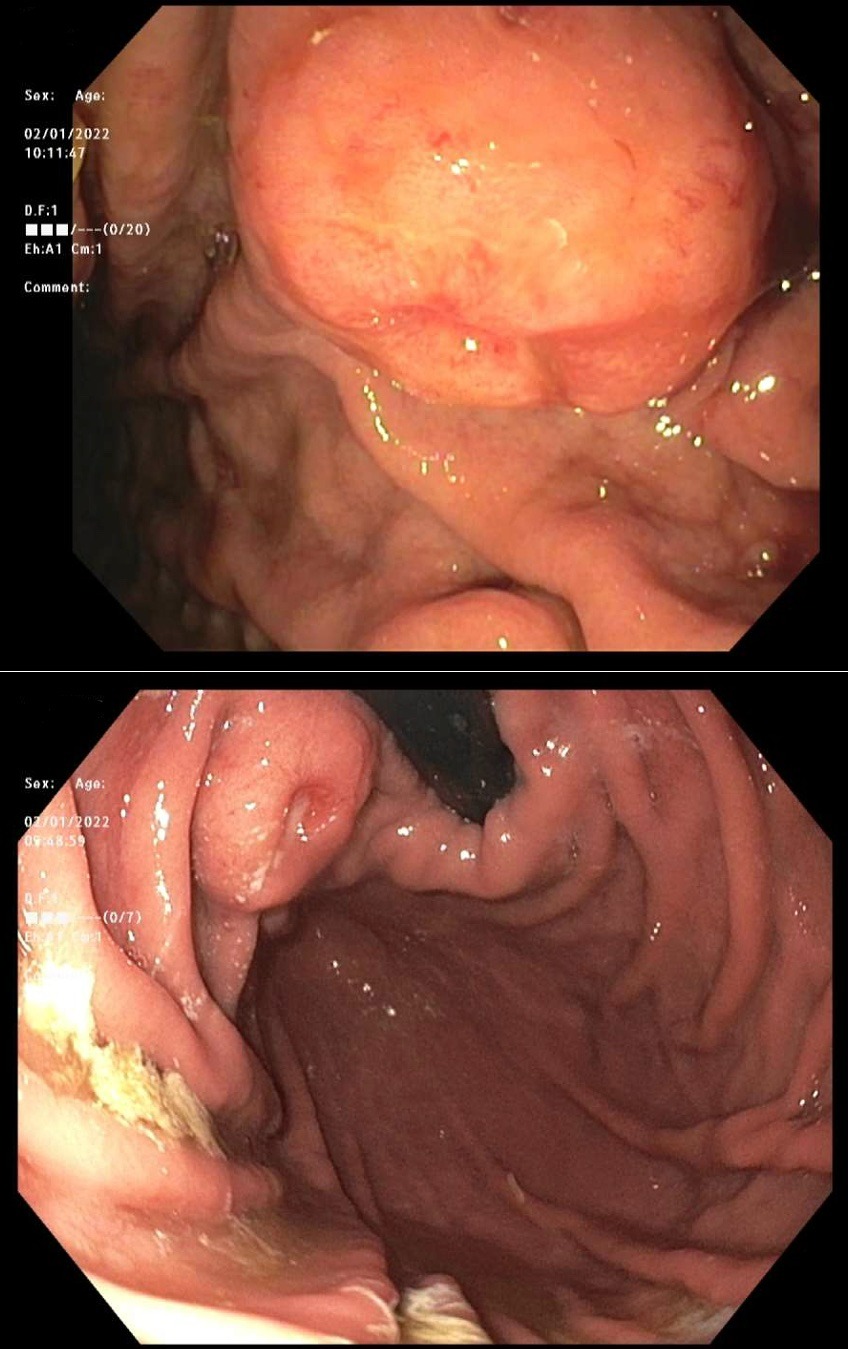Back


Poster Session E - Tuesday Afternoon
Category: Stomach
E0709 - Primary Gastric Synovial Sarcoma: A Case Report
Tuesday, October 25, 2022
3:00 PM – 5:00 PM ET
Location: Crown Ballroom

Has Audio

Fuad Khoury, MD, MPH
UPMC Mercy
Pittsburgh, PA
Presenting Author(s)
Fuad Khoury, MD, MPH1, Dominic Pezzone, DO1, Michael A. Pezzone, MD, PhD2
1UPMC Mercy, Pittsburgh, PA; 2University of Pittsburgh, Pittsburgh, PA
Introduction: Synovial sarcoma is an uncommon mesenchymal tumor, typically involving the extremities of young adults. This case outlines an especially rare occurrence of a primary synovial sarcoma occurring in the stomach of a 37-year-old female who ultimately required esophagogastrectomy.
Case Description/Methods: The patient is a 37-year-old female who initially presented with epigastric pain intermittently for more than a year. Her pain persisted and worsened. Her initial workup was negative and included an EGD, CT of the abdomen/pelvis, and HIDA scan. Several months later, an EGD was repeated due to ongoing symptoms. Her repeat EGD revealed a small ulcerated mass in the cardia, a c-KIT negative stromal tumor on histology. An EUS showed a 15mm, submucosal, ulcerated gastric mass, 1 cm from the GE junction (figure 1). A primary synovial sarcoma with immunohistochemical stains and FISH technology for SS18 translocation was identified. PET scanning showed no distant metastasis. The patient underwent a laparoscopic esophagogastrectomy with Roux-en-Y esophagojejunal anastomosis. Her final pathology confirmed a spindle cell sarcoma measuring 1.8 cm. Her post-operative course was uncomplicated. No further adjuvant radiation or chemotherapy was indicated.
Discussion: Synovial sarcomas account for approximately 10% of soft tissue tumors. Cell origin of these tumors are unknown, despite derivation of the name from the histological resemblance to synovial cells. These tumors are a result of chromosomal translocation t(X;18)p(11;qe1) which fuses the SS18 gene from chromosome 18 to the SSX gene on the X chromosome. Depending on which translocation occurs either a biphasic tumor (SS18-SSX1) or a monophasic tumor (SS18-SSX2) results.
Synovial sarcomas found in the gastrointestinal tract are exceptionally rare. As of 2021, 45 cases have been in the stomach. Mortality of localized primary synovial sarcomas is 75% at 5 years and 34% at 10 years in a recent large case series. Poor prognostic factors include a tumor diameter >5 cm and microscopically positive margins
Regarding treatment, resection is the primary option depending on size and location of the tumor. This patient underwent an esophagogastrectomy with clear margins. Rate of local recurrence is also high (30-50%) further supporting an esophagogastrectomy. Radiation is sometimes used as adjuvant or neoadjuvant therapy, and chemotherapy is typically reserved for metastatic disease.

Disclosures:
Fuad Khoury, MD, MPH1, Dominic Pezzone, DO1, Michael A. Pezzone, MD, PhD2. E0709 - Primary Gastric Synovial Sarcoma: A Case Report, ACG 2022 Annual Scientific Meeting Abstracts. Charlotte, NC: American College of Gastroenterology.
1UPMC Mercy, Pittsburgh, PA; 2University of Pittsburgh, Pittsburgh, PA
Introduction: Synovial sarcoma is an uncommon mesenchymal tumor, typically involving the extremities of young adults. This case outlines an especially rare occurrence of a primary synovial sarcoma occurring in the stomach of a 37-year-old female who ultimately required esophagogastrectomy.
Case Description/Methods: The patient is a 37-year-old female who initially presented with epigastric pain intermittently for more than a year. Her pain persisted and worsened. Her initial workup was negative and included an EGD, CT of the abdomen/pelvis, and HIDA scan. Several months later, an EGD was repeated due to ongoing symptoms. Her repeat EGD revealed a small ulcerated mass in the cardia, a c-KIT negative stromal tumor on histology. An EUS showed a 15mm, submucosal, ulcerated gastric mass, 1 cm from the GE junction (figure 1). A primary synovial sarcoma with immunohistochemical stains and FISH technology for SS18 translocation was identified. PET scanning showed no distant metastasis. The patient underwent a laparoscopic esophagogastrectomy with Roux-en-Y esophagojejunal anastomosis. Her final pathology confirmed a spindle cell sarcoma measuring 1.8 cm. Her post-operative course was uncomplicated. No further adjuvant radiation or chemotherapy was indicated.
Discussion: Synovial sarcomas account for approximately 10% of soft tissue tumors. Cell origin of these tumors are unknown, despite derivation of the name from the histological resemblance to synovial cells. These tumors are a result of chromosomal translocation t(X;18)p(11;qe1) which fuses the SS18 gene from chromosome 18 to the SSX gene on the X chromosome. Depending on which translocation occurs either a biphasic tumor (SS18-SSX1) or a monophasic tumor (SS18-SSX2) results.
Synovial sarcomas found in the gastrointestinal tract are exceptionally rare. As of 2021, 45 cases have been in the stomach. Mortality of localized primary synovial sarcomas is 75% at 5 years and 34% at 10 years in a recent large case series. Poor prognostic factors include a tumor diameter >5 cm and microscopically positive margins
Regarding treatment, resection is the primary option depending on size and location of the tumor. This patient underwent an esophagogastrectomy with clear margins. Rate of local recurrence is also high (30-50%) further supporting an esophagogastrectomy. Radiation is sometimes used as adjuvant or neoadjuvant therapy, and chemotherapy is typically reserved for metastatic disease.

Figure: 15mm, submucosal, ulcerated gastric mass, 1 cm from the GE junction
Disclosures:
Fuad Khoury indicated no relevant financial relationships.
Dominic Pezzone indicated no relevant financial relationships.
Michael Pezzone indicated no relevant financial relationships.
Fuad Khoury, MD, MPH1, Dominic Pezzone, DO1, Michael A. Pezzone, MD, PhD2. E0709 - Primary Gastric Synovial Sarcoma: A Case Report, ACG 2022 Annual Scientific Meeting Abstracts. Charlotte, NC: American College of Gastroenterology.
